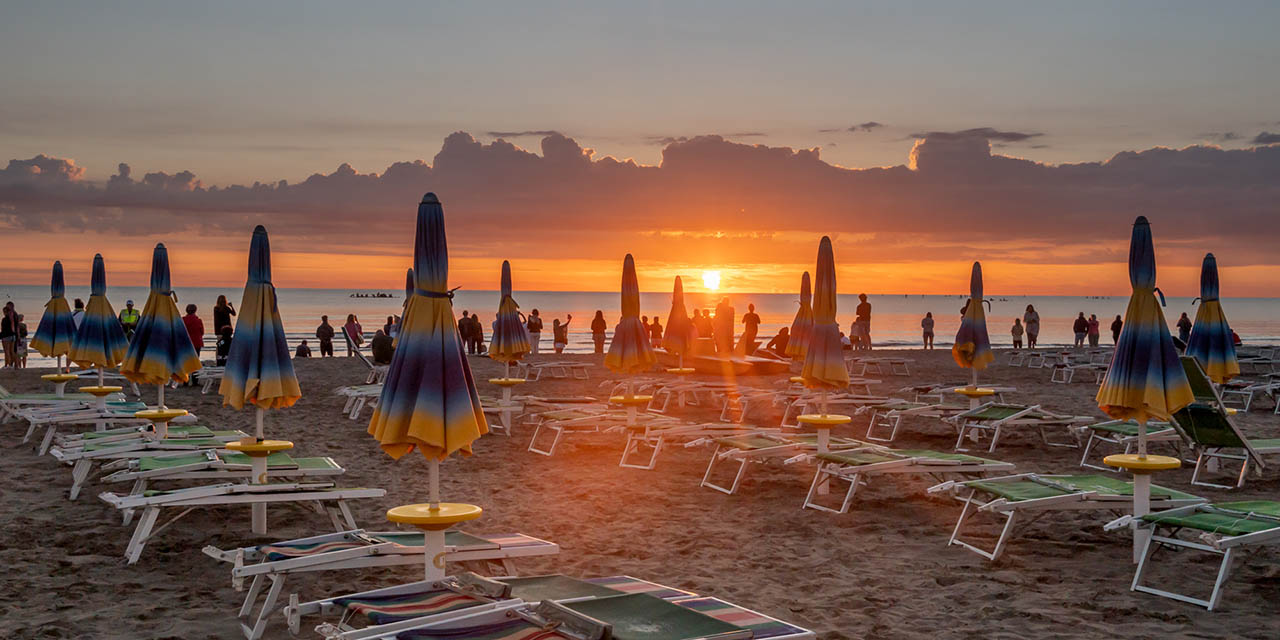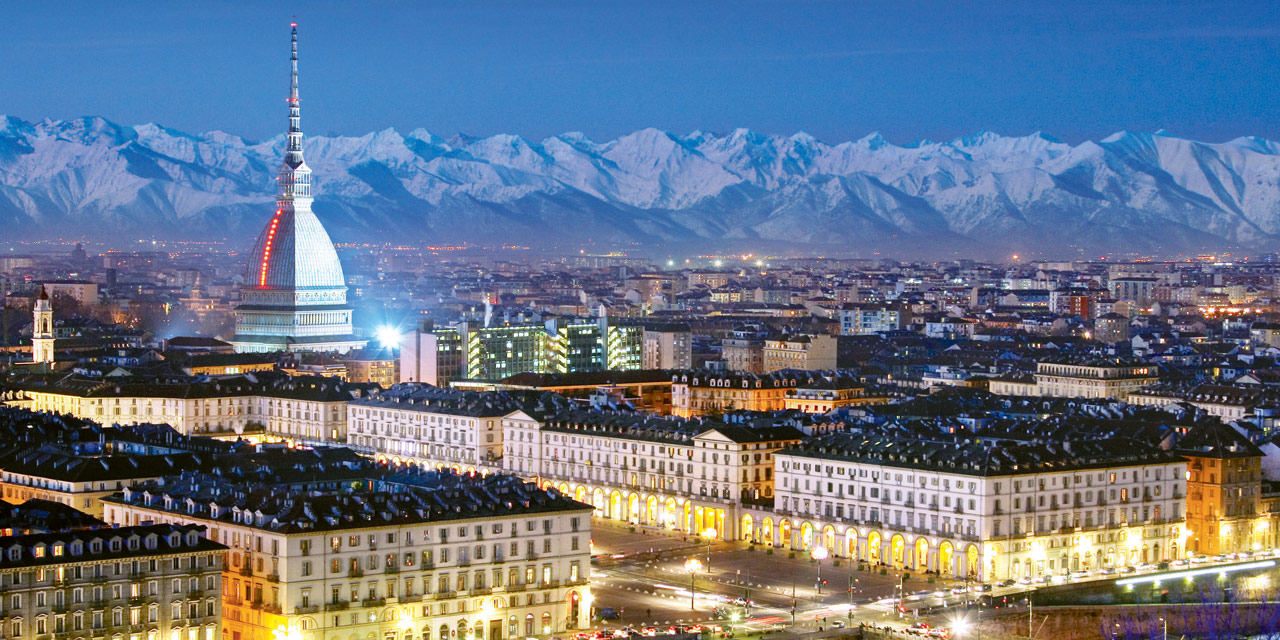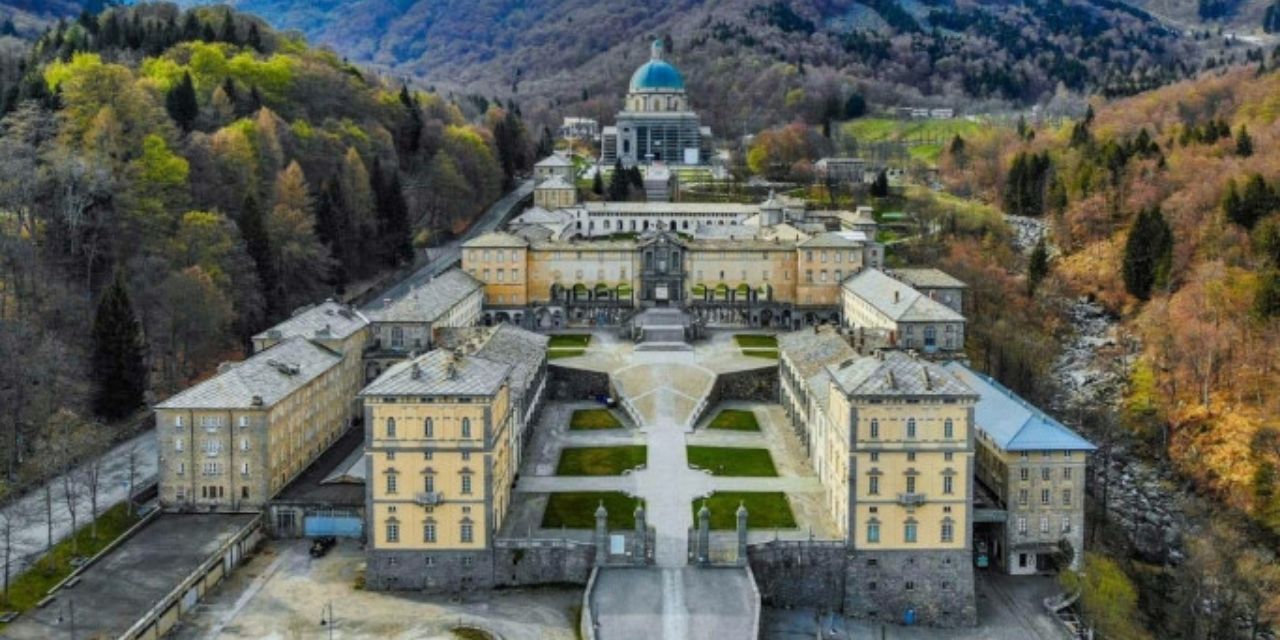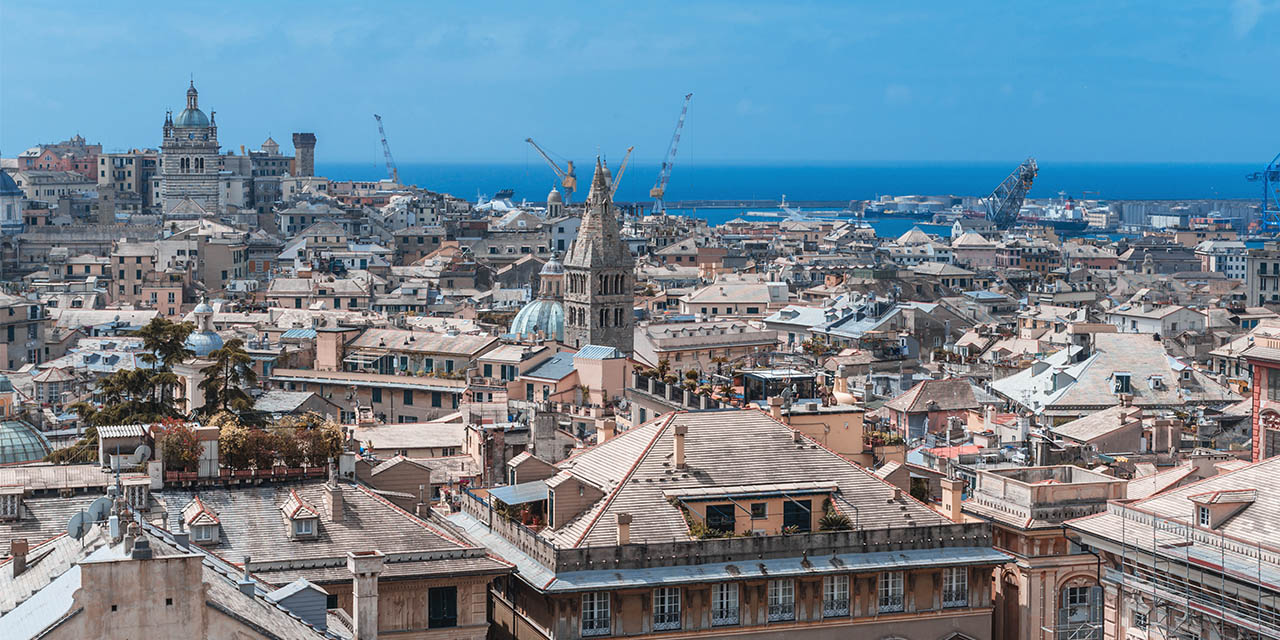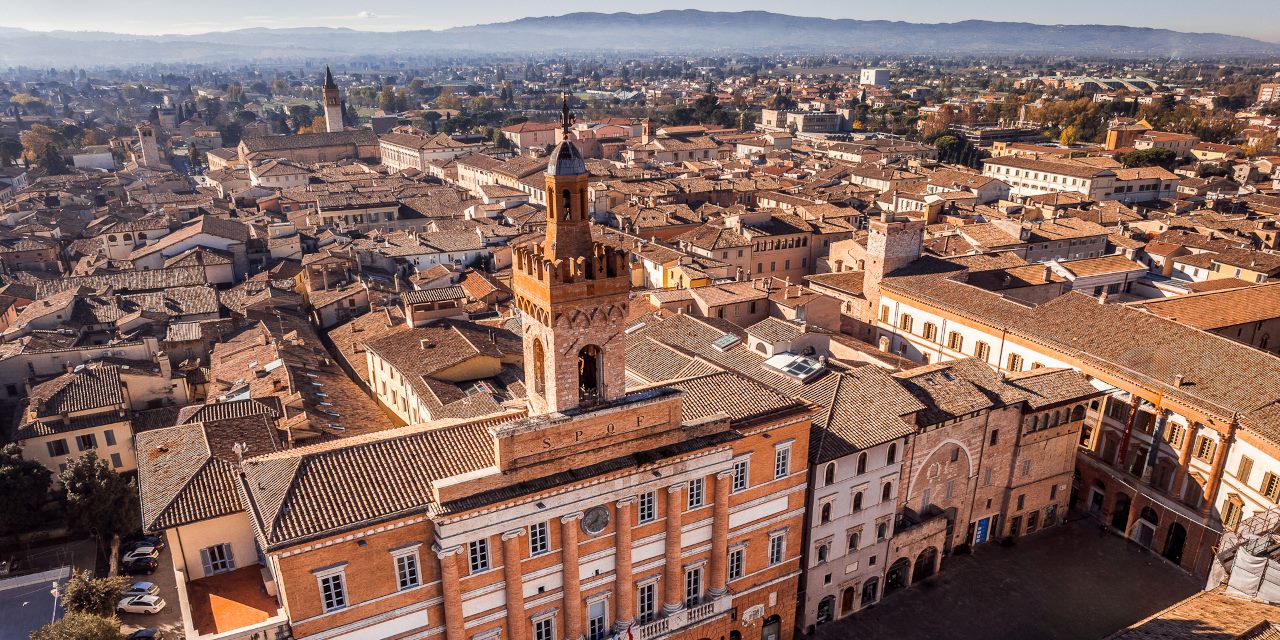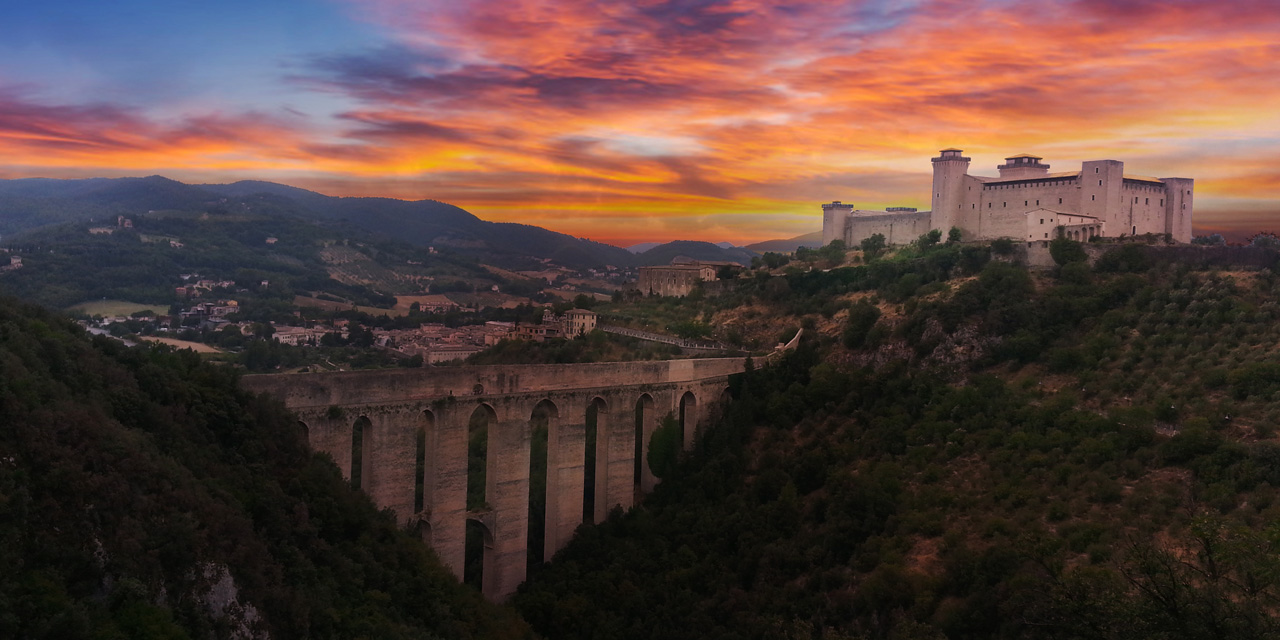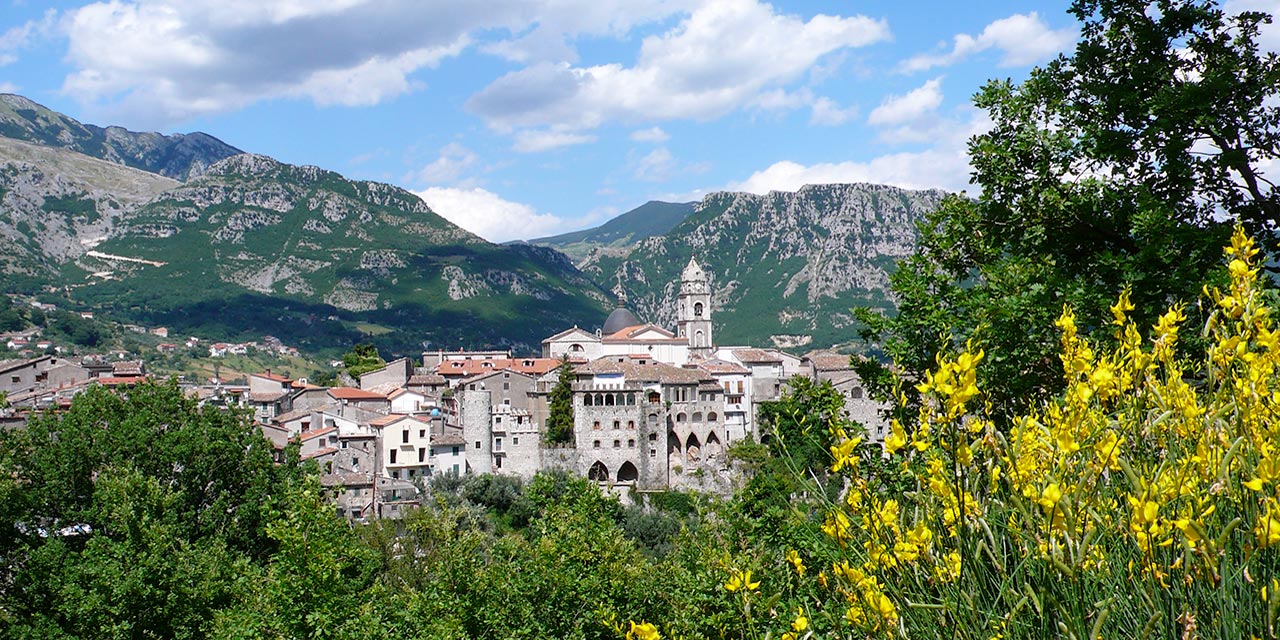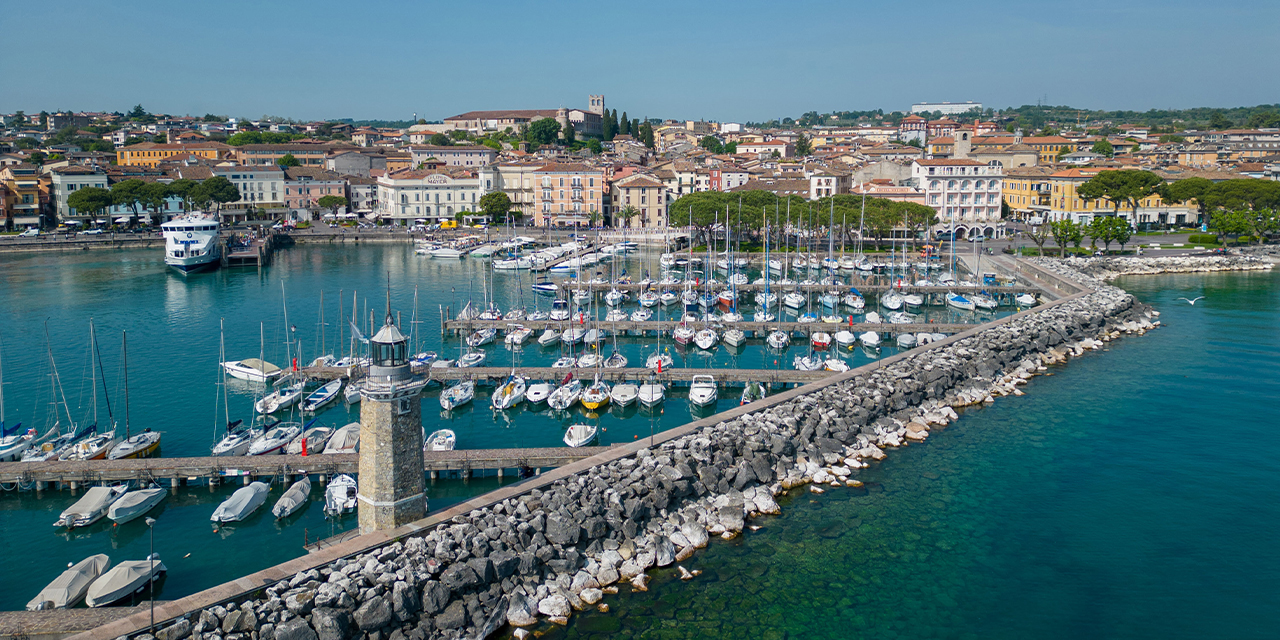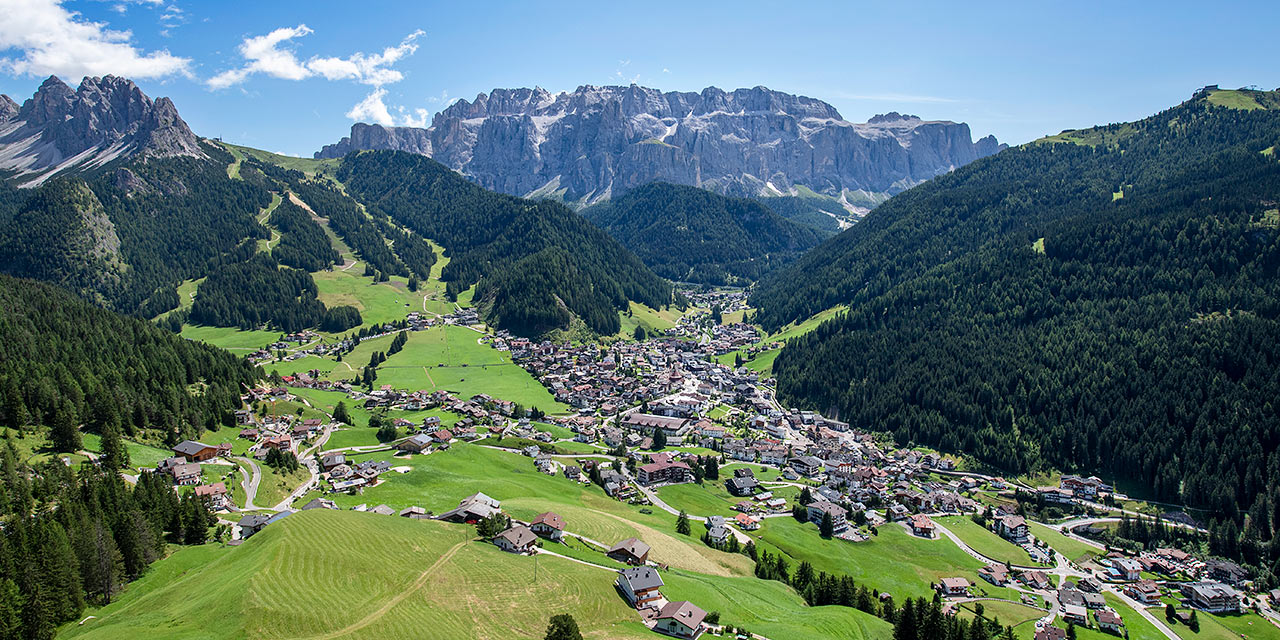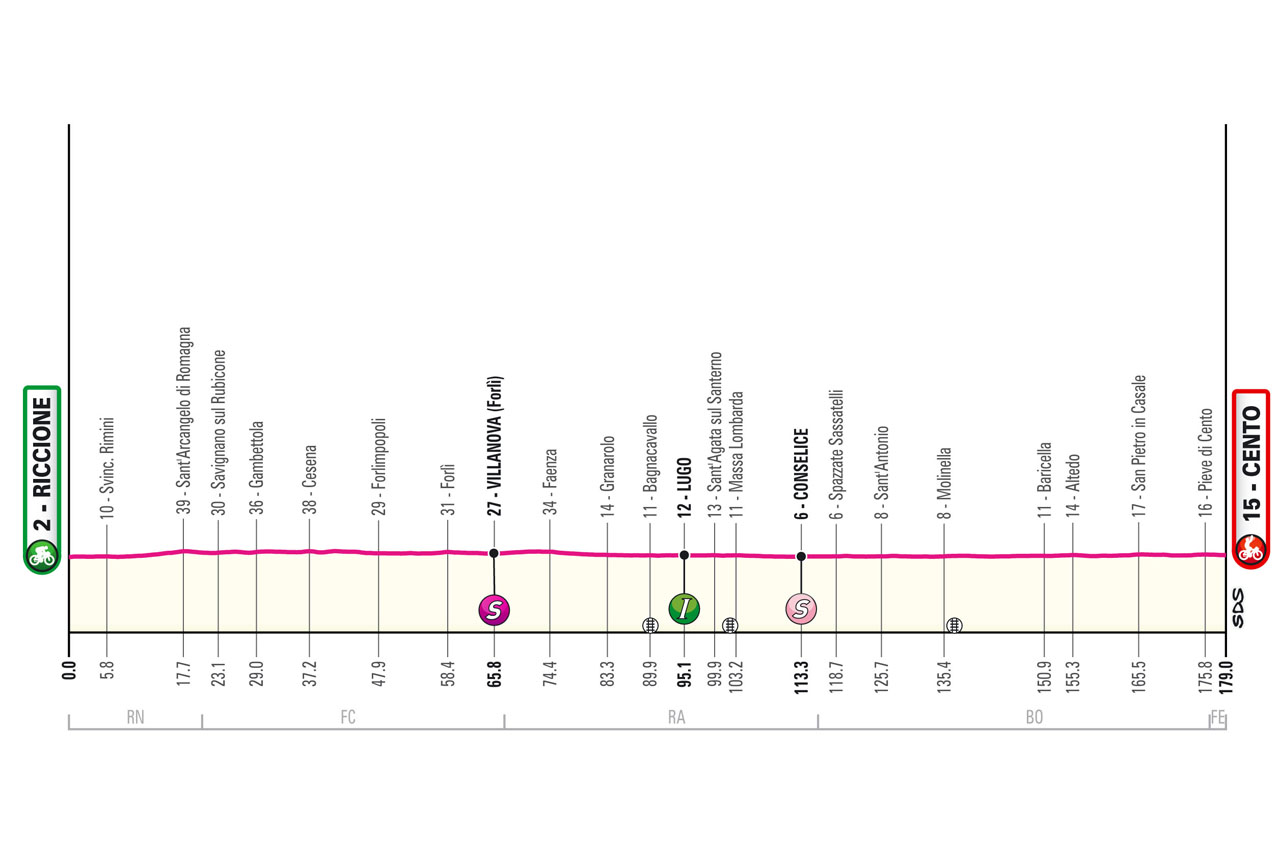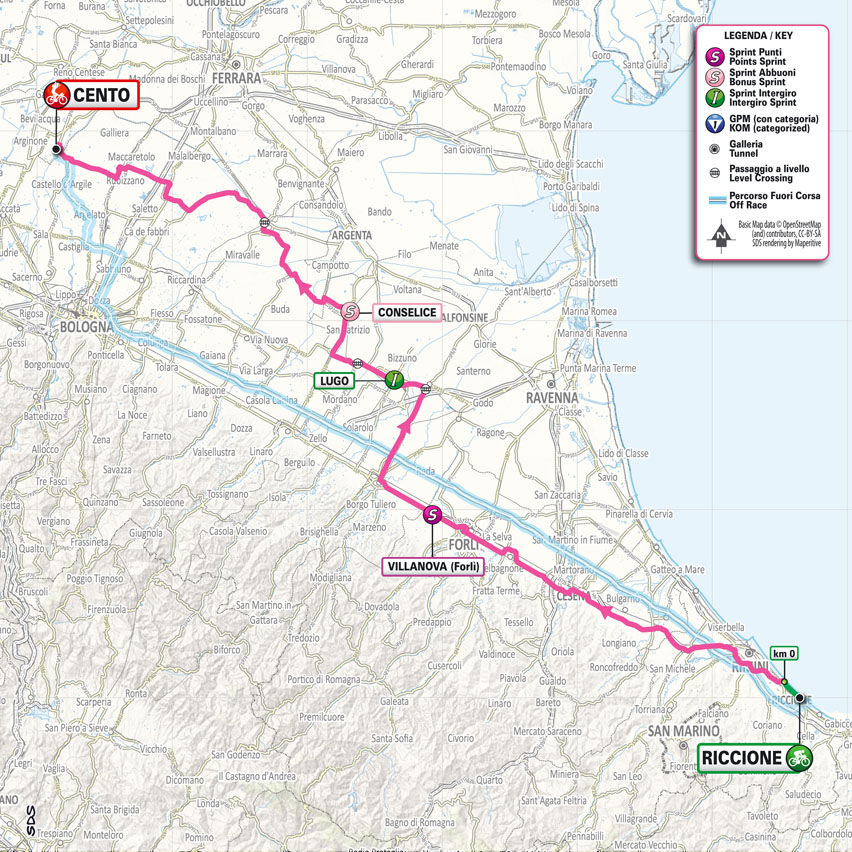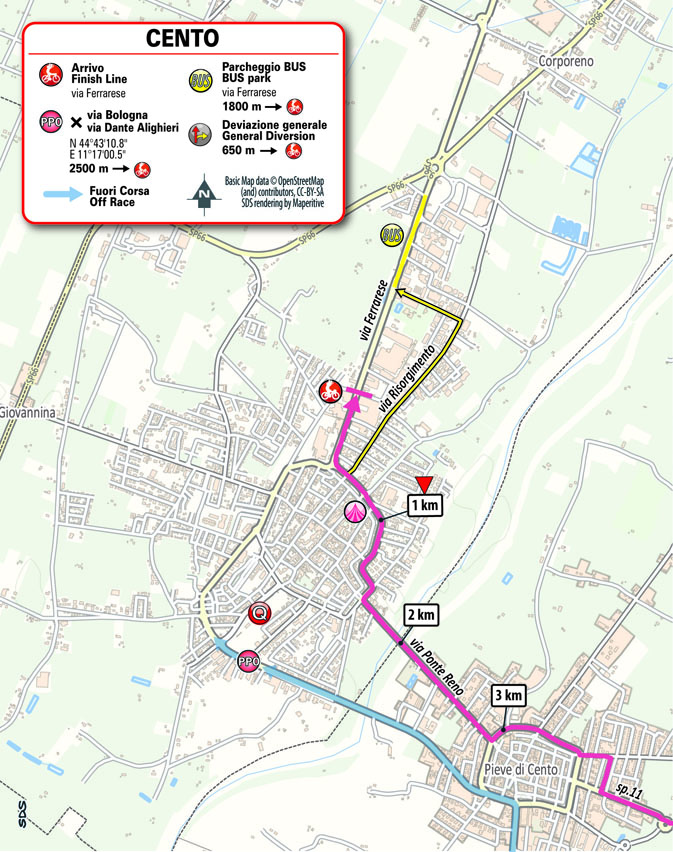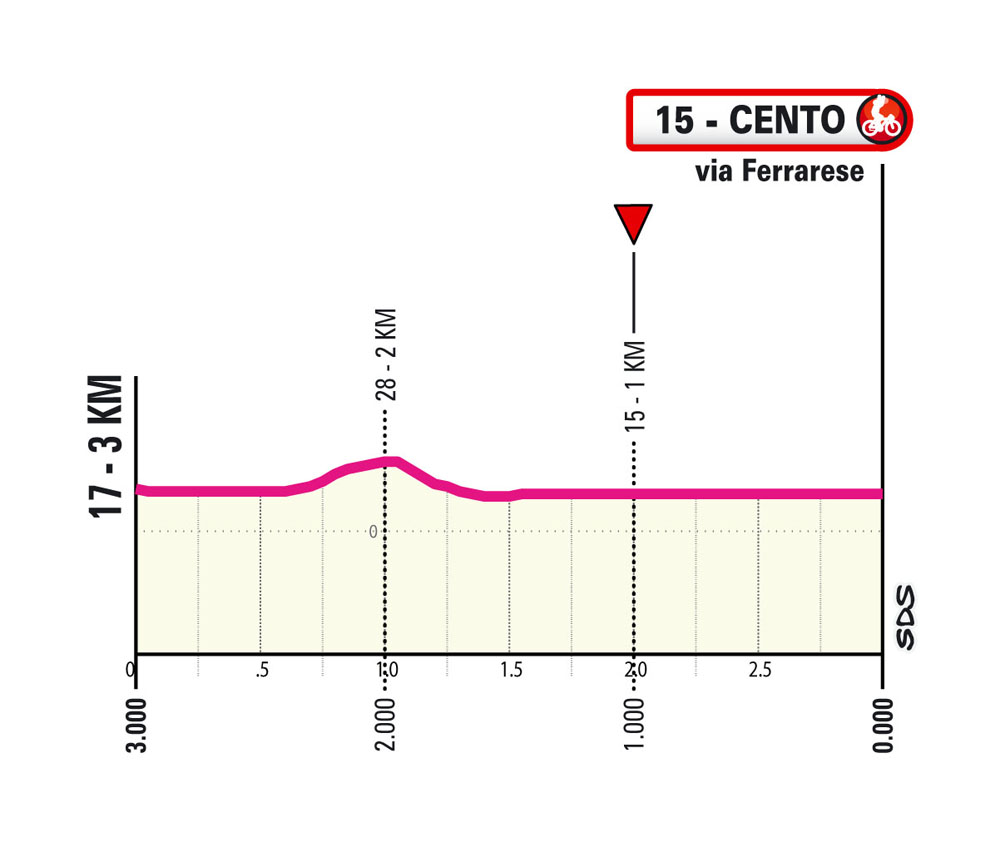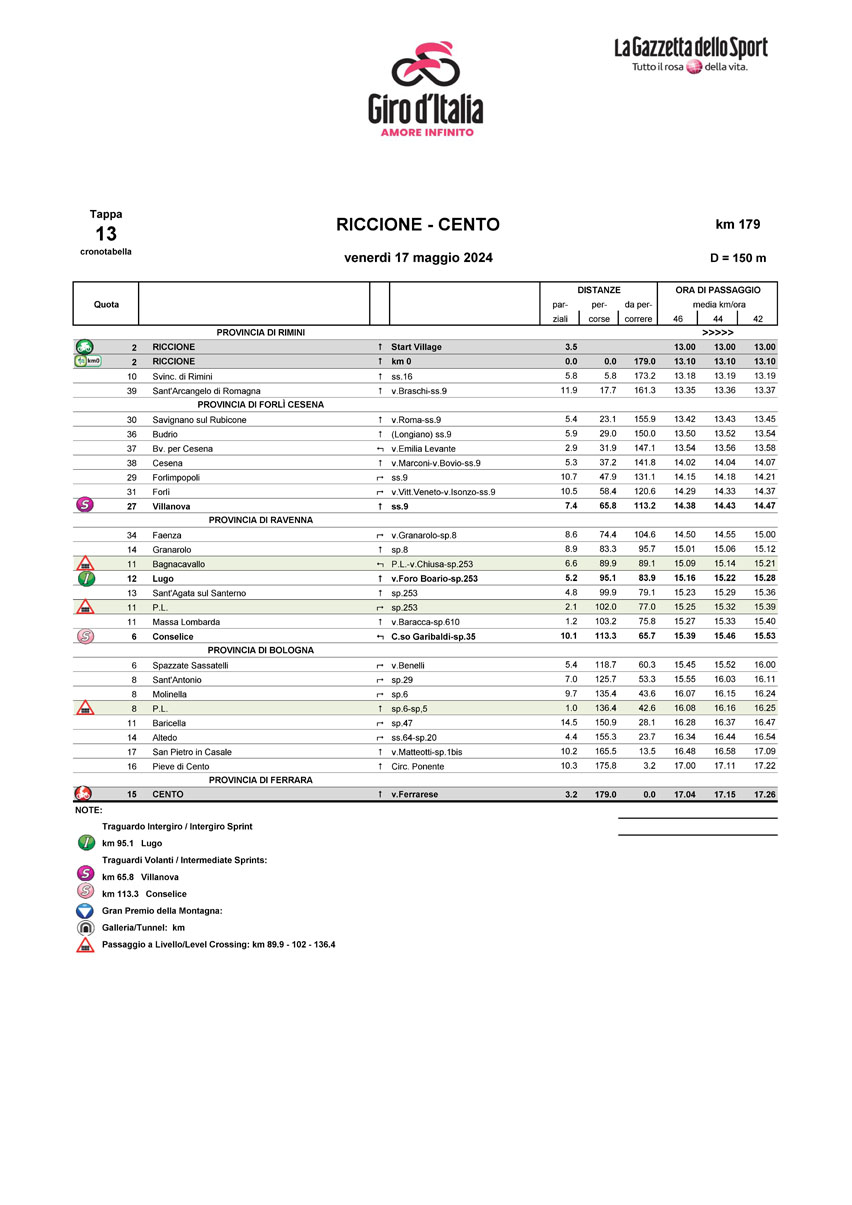profile
map
technical info
Completely flat stage through the plains of Emilia-Romagna. Mostly straight roads with variable carriageway widths, interspersed with residential areas with the usual traffic obstacles.
Last kilometres
The last kilometres are pretty much flat apart from the bridge over river Rhine. Some wide bends lead to the 450 m finishing straight on asphalt, width 8 m.
start / finish
final kilometres
itinerary timetable
tourist info
Host city:
Riccione
Overview
Riccione is one of the best-known and most appreciated tourist destinations on the Adriatic Riviera, a city with more than 35,000 inhabitants capable of attracting both Italian and foreign tourists thanks to its variety of services and large accommodation capacity that can meet all needs. The city has always stood out for its urban greenery – hence the name “Green Pearl of the Adriatic” – and is known as an elegant resort focused on the quality of life and wellbeing of its citizens and guests.
Points of Interest
The heart of the city is Viale Ceccarini, a long promenade leading from the station to the sea, known as a fashion and trend hot spot thanks to its boutiques, glittering jewellers and fancy clubs. The city centre, in particular the Viale Ceccarini and Viale Battisti area, features fine examples of seaside architecture dating back to the period between the late 19th and early 20th century surrounded by well-tended and carefully designed parks and gardens.
The avenue leads to the pedestrian promenade – an unmissable place to be enjoyed both during the day and in the evening, on foot or by bicycle – and to the nearby Villa Mussolini, a structure used to host international art exhibitions. Still in the downtown area, visitors can explore Villa Franceschi, which houses the Gallery of Modern and Contemporary Art, and take a break in the park of Villa Lodi Fè, another fine building from the same period. Near Viale Ceccarini, in the square of the same name, is the Palazzo del Turismo, dating from 1938, the first structure on the Adriatic designed to promote tourism and entertainment. A few steps from here is a place much loved by the people of Riccione: the port.
If you walk all the way along Viale Ceccarini north of the railway, you will reach Riccione Paese, the old town where visitors enjoy strolling among old shops, elegant cafés and where the Municipal Library and Territorial Museum are located.Up the hill, the panoramic site par excellence is the Agolanti Castle, built between 1324 and 1343 by the Agolanti family, vassals of the Malatesta family, lords of Rimini.
A few kilometres from the coast, in the immediate hinterland, stretch the beautiful valleys of the Conca and Marecchia rivers, full of green hills and historical and artistic testimonies. These are the lands that, between the Middle Ages and the Renaissance, were fought over by Sigismondo Malatesta, Lord of Rimini, and Federico da Montefeltro, Duke of Urbino. The fortresses and strongholds that can be seen at every corner still recount this turbulent but fascinating past.
Cento
Overview
Cento is synonymous with Carnival, one of the most famous and oldest in Europe! This festival was already well-known at the beginning of the 17th century, when the artist known as Guercino painted scenes of the costume party held in the town square. Radical changes have taken place since then, but Carnival remains an unmissable event that has been transformed over time to keep the enthusiasm alive.
Local Cusine
Salama da sugo di Buonacompra IGP: egend attributes an important role in reconstructing the product’s origins to Lucrezia Borgia, who married Alfonso d’Este in the early 1500s. The first written records of products very similar to ‘Salama da sugo’ date back to the Renaissance period.
Points of Interest
- Rocca: this imposing defensive structure was built in 1378, at the behest of Bernardo di Bonnevalle, bishop of Bologna, as a brake on the ambitions of autonomy of the people of Cento. It was rebuilt and renovated over the centuries to meet the most modern standards of military architecture and to withstand repeated assaults by enemy troops. At the end of the 18th century, the structure, by then in decay, was turned into a prison, a function it had already sporadically performed since the 16th century. Today, the interiors are completely restored and feature rooms of artistic or historical interest, such as the fireplace room, the chapel, the triforium room, the embrasures, the dungeons.
- Piazza del Guercino: the beating heart of city life and a thermometer of popular moods, Guercino Square hosts the most important cultural, religious and folklore events in town. Two important porticoed buildings of great historical and artistic value, the Town Hall and the Governor’s Palace, form the backdrop to the square.
- The Art Gallery: after having been closed for more than ten years due to the earthquake that struck the Emilia region in 2012, the “il Guercino” Civic Art Gallery is now the main cultural venue in Cento. It houses the largest collection in the world of masterpieces by illustrious local artist Giovanni Francesco Barbieri, known as ‘il Guercino’ as well as his old workshop.
- Giant’s Park: the Giant’s Garden is a masterpiece of environmental art, set in a public green area in the municipality of Cento. Its story originated from the imagination of a little girl, and became reality thanks to the creativity of artist Marco Pellizzola, the collaboration of numerous students from the Academy of Fine Arts, and the contribution of various sponsors. The work features a 33-metre lizard stretched out on the lawn, a leaf measuring 5×12 metres rising towards the sky, a 13-metre blackbird perched on a small hill… and then shooting stars, small fish, flowers and water lilies, dozens and dozens of birds escaped from their cages, signs, symbols and fragments of dreamlike architecture inspired by the natural world, for a fast-paced sequence of shapes and images coloured by thousands of ceramic mosaic fragments.
- The Carnival of Cento: recognised as a National Historic Carnival by the Ministry of Culture and as a Regional Historic Carnival by the Emilia-Romagna Region. The undisputed protagonist is the parade of allegorical floats, enormous papier-mâché monuments up to 20 metres high, resulting from the long and skilful craftsmanship of the masters of the five Cento Carnival Associations. While the colourful costumed figures and characters accompany the parade, a rainbow of prizes and gifts is poured onto the public from the highest towers of the floats. The carnival concludes with the reading of the “Will of TASI”, the traditional mask of Cento, and the ritual burning of the straw and papier-mâché puppet that represents him.

